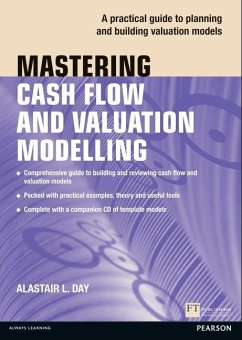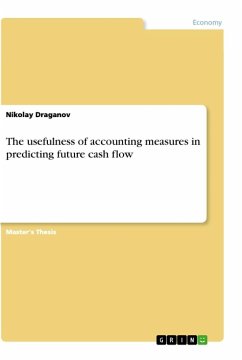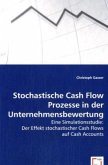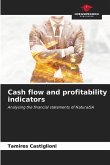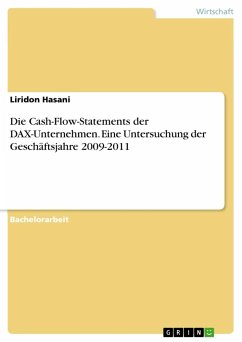Alastair L. Day
Mastering Cash Flow and Valuation Modelling
Alastair L. Day
Mastering Cash Flow and Valuation Modelling
- Broschiertes Buch
- Merkliste
- Auf die Merkliste
- Bewerten Bewerten
- Teilen
- Produkt teilen
- Produkterinnerung
- Produkterinnerung
Your practical step-by-step guide to planning and building cash valuation models. Through a set of comprehensive instructions and templates it provides the tools to build models that will enable you to carry out accurate and informed analysis of your company's cash liabilities, cash flow and value.
Andere Kunden interessierten sich auch für
![The usefulness of accounting measures in predicting future cash flow The usefulness of accounting measures in predicting future cash flow]() Nikolay DraganovThe usefulness of accounting measures in predicting future cash flow27,95 €
Nikolay DraganovThe usefulness of accounting measures in predicting future cash flow27,95 €![Discounted Cash Flow Valuation of Spotify Discounted Cash Flow Valuation of Spotify]() Olaya GesteiraDiscounted Cash Flow Valuation of Spotify42,95 €
Olaya GesteiraDiscounted Cash Flow Valuation of Spotify42,95 €![Stochastische Cash Flow Prozesse in der Unternehmensbewertung Stochastische Cash Flow Prozesse in der Unternehmensbewertung]() Christoph GasserStochastische Cash Flow Prozesse in der Unternehmensbewertung33,99 €
Christoph GasserStochastische Cash Flow Prozesse in der Unternehmensbewertung33,99 €![Unternehmensbewertung mittels Discounted Cash-Flow Analysen Unternehmensbewertung mittels Discounted Cash-Flow Analysen]() Jens WingenfeldUnternehmensbewertung mittels Discounted Cash-Flow Analysen58,00 €
Jens WingenfeldUnternehmensbewertung mittels Discounted Cash-Flow Analysen58,00 €![Die Prognose von Ertragsteuern im Discounted Cash Flow-Verfahren Die Prognose von Ertragsteuern im Discounted Cash Flow-Verfahren]() Wilhelm SchmundtDie Prognose von Ertragsteuern im Discounted Cash Flow-Verfahren69,95 €
Wilhelm SchmundtDie Prognose von Ertragsteuern im Discounted Cash Flow-Verfahren69,95 €![Cash flow and profitability indicators Cash flow and profitability indicators]() Tamires CastiglioniCash flow and profitability indicators26,99 €
Tamires CastiglioniCash flow and profitability indicators26,99 €![Die Cash-Flow-Statements der DAX-Unternehmen. Eine Untersuchung der Geschäftsjahre 2009-2011 Die Cash-Flow-Statements der DAX-Unternehmen. Eine Untersuchung der Geschäftsjahre 2009-2011]() Liridon HasaniDie Cash-Flow-Statements der DAX-Unternehmen. Eine Untersuchung der Geschäftsjahre 2009-201127,95 €
Liridon HasaniDie Cash-Flow-Statements der DAX-Unternehmen. Eine Untersuchung der Geschäftsjahre 2009-201127,95 €-
-
-
Your practical step-by-step guide to planning and building cash valuation models. Through a set of comprehensive instructions and templates it provides the tools to build models that will enable you to carry out accurate and informed analysis of your company's cash liabilities, cash flow and value.
Hinweis: Dieser Artikel kann nur an eine deutsche Lieferadresse ausgeliefert werden.
Hinweis: Dieser Artikel kann nur an eine deutsche Lieferadresse ausgeliefert werden.
Produktdetails
- Produktdetails
- Financial Times Series
- Verlag: Financial Times / Pearson
- Seitenzahl: 344
- Erscheinungstermin: 9. November 2011
- Englisch
- Abmessung: 246mm x 174mm x 23mm
- Gewicht: 616g
- ISBN-13: 9780273732815
- ISBN-10: 0273732811
- Artikelnr.: 33766089
- Herstellerkennzeichnung
- Libri GmbH
- Europaallee 1
- 36244 Bad Hersfeld
- gpsr@libri.de
- Financial Times Series
- Verlag: Financial Times / Pearson
- Seitenzahl: 344
- Erscheinungstermin: 9. November 2011
- Englisch
- Abmessung: 246mm x 174mm x 23mm
- Gewicht: 616g
- ISBN-13: 9780273732815
- ISBN-10: 0273732811
- Artikelnr.: 33766089
- Herstellerkennzeichnung
- Libri GmbH
- Europaallee 1
- 36244 Bad Hersfeld
- gpsr@libri.de
Alastair Day has worked in the finance industry for 20 years in treasury and marketing functions. In 1990 he established Systematic Finance as a consultancy and financial lessor concentrating on the computer and communications industries. Alastair has a degree in Economics and German from London University, an MBA from the Open University Business School, and is an associate lecturer in corporate finance with the OUBS. He is the successful author of several books including Mastering financial Modelling, Mastering Risk Modelling and The Financial Directors Guide to Purchasing Leasing.
Acknowledgements
About the author
Conventions
Overview
Executive summary
Warranty and disclaimer
1 Introduction and overview
Scope of the book
Model design methodology
Example models
Summary
2 Functions
Categories
Finance
Mathematics
Time
Lookup
Logic
Text
Other functions
Summary
3 Model template
Design objectives
Systematic design method
Case objectives
Templates
Input sheet
Timeline
Summary
4 Historic statements
Accounting sheets
Income Statement
Balance sheet
Adjustments
Summary
5 Sales forecast
Forecasting objectives
Method
Sales
Common size analysis
Forecast sheet
Summary
6 Assets
Fixed assets
Excel functions
Existing assets
New asset depreciation
Written down value
Asset summary
Tax depreciation
Summary
7 Debt
Debt schedule
Required entries
Interest rates
Forecast income statement
Forecast balance sheet
Summary
8 Balance sheet
Current assets
Non-current assets
Current liabilities
Long-term liabilities and shareholders funds
Tax
Balancing item
Summary
9 Cash flow
Outline
Cash flow statement
Cash for debt service
Cash waterfall
Chart
Summary
10 Ratios
Method
Common size analysis
Core ratios
Profitability
Operating efficiency
Financial structure
Cash flow
Debt coverage
Growth
Market ratios
Summary
11 Cost of capital
Background
Cost of debt
Preference capital
Historic cost of equity
Forecast cost of equity
Cost of capital
Graphical representation
Summary
12 Valuation
Cash flows
Terminal value
Choice of method
Initial valuation
Chart
Summary
13 Other approaches
Method
Book value
Adjusted book value
Market value
Multiples
Peer data
Summary
14 Alternative methods
Method
Adjusted present value
Economic profit
Summary
15 Sensitivity
Outline
Returns
Data matrix
Scenario manager
Manual scenarios
Summary
16 Optimisation
Outline
Goal Seek
Solver
Coding Solver
Summary
17 Reporting
Reporting
Executive summary
Dashboard
Dynamic charts
Summary
18 Auditing and review
Model review
Self-checks
Excel audits tools
Consistency checks
Audit sheet
Summary
19 Documentation
Documentation
Navigation
Protection
Version check
Final review
Summary
Appendices
1 Functions list, software installation and licence
2 An introduction to Microsoft® Office 2010 (Office 14)
Index
About the author
Conventions
Overview
Executive summary
Warranty and disclaimer
1 Introduction and overview
Scope of the book
Model design methodology
Example models
Summary
2 Functions
Categories
Finance
Mathematics
Time
Lookup
Logic
Text
Other functions
Summary
3 Model template
Design objectives
Systematic design method
Case objectives
Templates
Input sheet
Timeline
Summary
4 Historic statements
Accounting sheets
Income Statement
Balance sheet
Adjustments
Summary
5 Sales forecast
Forecasting objectives
Method
Sales
Common size analysis
Forecast sheet
Summary
6 Assets
Fixed assets
Excel functions
Existing assets
New asset depreciation
Written down value
Asset summary
Tax depreciation
Summary
7 Debt
Debt schedule
Required entries
Interest rates
Forecast income statement
Forecast balance sheet
Summary
8 Balance sheet
Current assets
Non-current assets
Current liabilities
Long-term liabilities and shareholders funds
Tax
Balancing item
Summary
9 Cash flow
Outline
Cash flow statement
Cash for debt service
Cash waterfall
Chart
Summary
10 Ratios
Method
Common size analysis
Core ratios
Profitability
Operating efficiency
Financial structure
Cash flow
Debt coverage
Growth
Market ratios
Summary
11 Cost of capital
Background
Cost of debt
Preference capital
Historic cost of equity
Forecast cost of equity
Cost of capital
Graphical representation
Summary
12 Valuation
Cash flows
Terminal value
Choice of method
Initial valuation
Chart
Summary
13 Other approaches
Method
Book value
Adjusted book value
Market value
Multiples
Peer data
Summary
14 Alternative methods
Method
Adjusted present value
Economic profit
Summary
15 Sensitivity
Outline
Returns
Data matrix
Scenario manager
Manual scenarios
Summary
16 Optimisation
Outline
Goal Seek
Solver
Coding Solver
Summary
17 Reporting
Reporting
Executive summary
Dashboard
Dynamic charts
Summary
18 Auditing and review
Model review
Self-checks
Excel audits tools
Consistency checks
Audit sheet
Summary
19 Documentation
Documentation
Navigation
Protection
Version check
Final review
Summary
Appendices
1 Functions list, software installation and licence
2 An introduction to Microsoft® Office 2010 (Office 14)
Index
Acknowledgements
About the author
Conventions
Overview
Executive summary
Warranty and disclaimer
1 Introduction and overview
Scope of the book
Model design methodology
Example models
Summary
2 Functions
Categories
Finance
Mathematics
Time
Lookup
Logic
Text
Other functions
Summary
3 Model template
Design objectives
Systematic design method
Case objectives
Templates
Input sheet
Timeline
Summary
4 Historic statements
Accounting sheets
Income Statement
Balance sheet
Adjustments
Summary
5 Sales forecast
Forecasting objectives
Method
Sales
Common size analysis
Forecast sheet
Summary
6 Assets
Fixed assets
Excel functions
Existing assets
New asset depreciation
Written down value
Asset summary
Tax depreciation
Summary
7 Debt
Debt schedule
Required entries
Interest rates
Forecast income statement
Forecast balance sheet
Summary
8 Balance sheet
Current assets
Non-current assets
Current liabilities
Long-term liabilities and shareholders funds
Tax
Balancing item
Summary
9 Cash flow
Outline
Cash flow statement
Cash for debt service
Cash waterfall
Chart
Summary
10 Ratios
Method
Common size analysis
Core ratios
Profitability
Operating efficiency
Financial structure
Cash flow
Debt coverage
Growth
Market ratios
Summary
11 Cost of capital
Background
Cost of debt
Preference capital
Historic cost of equity
Forecast cost of equity
Cost of capital
Graphical representation
Summary
12 Valuation
Cash flows
Terminal value
Choice of method
Initial valuation
Chart
Summary
13 Other approaches
Method
Book value
Adjusted book value
Market value
Multiples
Peer data
Summary
14 Alternative methods
Method
Adjusted present value
Economic profit
Summary
15 Sensitivity
Outline
Returns
Data matrix
Scenario manager
Manual scenarios
Summary
16 Optimisation
Outline
Goal Seek
Solver
Coding Solver
Summary
17 Reporting
Reporting
Executive summary
Dashboard
Dynamic charts
Summary
18 Auditing and review
Model review
Self-checks
Excel audits tools
Consistency checks
Audit sheet
Summary
19 Documentation
Documentation
Navigation
Protection
Version check
Final review
Summary
Appendices
1 Functions list, software installation and licence
2 An introduction to Microsoft® Office 2010 (Office 14)
Index
About the author
Conventions
Overview
Executive summary
Warranty and disclaimer
1 Introduction and overview
Scope of the book
Model design methodology
Example models
Summary
2 Functions
Categories
Finance
Mathematics
Time
Lookup
Logic
Text
Other functions
Summary
3 Model template
Design objectives
Systematic design method
Case objectives
Templates
Input sheet
Timeline
Summary
4 Historic statements
Accounting sheets
Income Statement
Balance sheet
Adjustments
Summary
5 Sales forecast
Forecasting objectives
Method
Sales
Common size analysis
Forecast sheet
Summary
6 Assets
Fixed assets
Excel functions
Existing assets
New asset depreciation
Written down value
Asset summary
Tax depreciation
Summary
7 Debt
Debt schedule
Required entries
Interest rates
Forecast income statement
Forecast balance sheet
Summary
8 Balance sheet
Current assets
Non-current assets
Current liabilities
Long-term liabilities and shareholders funds
Tax
Balancing item
Summary
9 Cash flow
Outline
Cash flow statement
Cash for debt service
Cash waterfall
Chart
Summary
10 Ratios
Method
Common size analysis
Core ratios
Profitability
Operating efficiency
Financial structure
Cash flow
Debt coverage
Growth
Market ratios
Summary
11 Cost of capital
Background
Cost of debt
Preference capital
Historic cost of equity
Forecast cost of equity
Cost of capital
Graphical representation
Summary
12 Valuation
Cash flows
Terminal value
Choice of method
Initial valuation
Chart
Summary
13 Other approaches
Method
Book value
Adjusted book value
Market value
Multiples
Peer data
Summary
14 Alternative methods
Method
Adjusted present value
Economic profit
Summary
15 Sensitivity
Outline
Returns
Data matrix
Scenario manager
Manual scenarios
Summary
16 Optimisation
Outline
Goal Seek
Solver
Coding Solver
Summary
17 Reporting
Reporting
Executive summary
Dashboard
Dynamic charts
Summary
18 Auditing and review
Model review
Self-checks
Excel audits tools
Consistency checks
Audit sheet
Summary
19 Documentation
Documentation
Navigation
Protection
Version check
Final review
Summary
Appendices
1 Functions list, software installation and licence
2 An introduction to Microsoft® Office 2010 (Office 14)
Index

